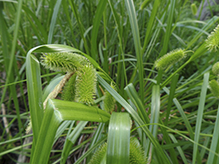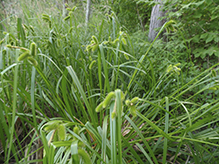bristly sedge
(Carex comosa)
Conservation • Wetland • Description • Habitat • Ecology • Use • Distribution • Taxonomy
Description |
||
Bristly sedge is a large, broad-leaved, true sedge. It occurs in the eastern United States from Maine to Florida west to Minnesota and Louisiana, in the west from Washington to California, in adjacent Canadian provinces, and in Mexico. It is found in swamps, marshes, wet thickets, and depressions in wet meadows; on the shores of ponds and lakes; and on floating mats of vegetation. It is often emergent in shallow water, near or even well away from the shore. It sometimes roots on floating logs. Bristly sedge is an erect, perennial sedge that rises in a loose or dense clump from a short, horizontal, underground stem (rhizome) and fibrous roots. Both sterile (vegetative) and fertile (flowering) stems (culms) are produced, more of the former than the latter. The vegetative culms are well-developed and have several leaves. Flowering culms are 20″ to 47″ (50 to 120 cm) tall. They are erect, unbranched, leafy, and three-sided with sharp edges. They are hairless, rough to the touch near the top, and tinged brownish at the base. Stem leaves are alternate and widely spreading to ascending. They appear along the entire length of the culm below the inflorescence. All of the leaves, even at the base, have well-developed blades. The leaf blade is hairless, light green to medium green, 8″ to 20″ (20 to 50 cm) long, and 3⁄16″ to ⅝″ (5 to 16 mm) wide. It is usually W-shaped in cross section, sometimes flat. The sheath is hairless, deeply concave at the tip, light green and veined on the outer side, papery (membranous) on the inner side. The sheath of the lowermost leaves is pale brown at the base. The sheath does not break into horizontal ladder-like fibers as it ages, and there is no red or purple coloration at the base. The sheaths of the previous season persist and are noticeable at the base of the plant. The ligule is V-shaped and longer than wide. The inflorescence is a 1½″ to 13¾″ (4 to 35 cm) long, loosely spaced arrangement of spikes. There is a single male (staminate) spike at the tip of the stem and 2 to 6 female (pistillate) spikes near the top of the stem. The inflorescence is subtended by a single, 6″ to 33½″ (15 to 85 cm) long, inflorescence leaf (bract). The bract is much longer than the inflorescence. The staminate spike is cylindrical and 1″ to 3⅛″ (25 to 80 mm) long. It is held erect on a slender stalk (peduncle) that is up to ⅜″ (10 mm) long. Each male flower is subtended by a single modified leaf (scale). The staminate scale is lance-shaped to linear, ⅛″ to ⅜″ (4 to 9 mm) long, and tapered to a rough (scabrous), bristle-like tip (awn). It is reddish-brown and has a green or straw-colored midrib. The pistillate spikes are cylindrical, ⅝″ to 3″ (15 to 75 mm) long, and ½″ to ¾″ (12 to 18 mm) wide. They are on up to 1″ long or longer peduncles. The upper spikes are spreading, the lower ones drooping. Each spike has numerous flowers, and each flower is surrounded by a modified bract (perigynium). At the base of each perigynia is a single scale. The pistillate scale is lance-shaped, ⅛″ to ½″ (2.8 to 12 mm) long, 1⁄64″ to 1⁄32″ (0.4 to 1.0 mm) wide, and narrowed with concave sides (acuminate) toward the tip. It is shorter than the perigynium. The tip tapers to a long scabrous awn. The perigynia are crowded and are spreading to bent backwards (reflexed) when mature. Each perigynium is narrowly egg-shaped. leathery, 3⁄16″ to ⅜″ (4.8 to 8.7 mm) long, and 1⁄32″ to 1⁄16″(1.1 to 1.8 mm) wide. It entirely and tightly envelopes the achene at maturity. It is abruptly contracted into a long beak at the tip. It has 14 to 22 distinct, closely-spaced veins that converge about half way up the beak. The beak is tube-shaped, 1⁄16″to ⅛″ (2 to 4 mm) long, and has two papery teeth at the tip. The teeth are 1⁄32″to ⅛″ (2 to 3 mm) long and are distinctly curved outward. The fruit is a dry seed capsule (achene). The achene is pale brown, 1⁄16″ (1.7 to 2.0 mm) long, and triangular in cross section. It matures in late June to mid-September. |
||
Height |
||
20″ to 47″ (50 to 120 cm) |
||
Similar Species |
||
Habitat |
||
Swamps, marshes, wet thickets, depressions in wet meadows, shores of ponds and lakes, floating mats of vegetation, and floating logs. Often emergent in shallow water. |
||
Ecology |
||
Fruiting |
||
| April to June | ||
Maturing |
||
Late June to mid-September |
||
Pests and Diseases |
||
|
||
Use |
||
|
||
Distribution |
||||
|
Sources |
|||
| 3/3/2023 | ||||
Nativity |
||||
Native |
||||
Occurrence |
||||
Common |
||||
Taxonomy |
|||
| Kingdom | Plantae (green algae and land plants) | ||
| Subkingdom | Viridiplantae (green plants) | ||
| Infrakingdom | Streptophyta (land plants and green algae) | ||
| Superdivision | Embryophyta (land plants) | ||
| Division | Tracheophyta (vascular plants) | ||
| Subdivision | Spermatophytina (seed plants) | ||
| Class | Liliopsida (monocots) | ||
Order |
Poales (grasses, sedges, cattails, and allies) | ||
Family |
Cyperaceae (sedges) | ||
| Subfamily | Cyperoideae | ||
| Tribe | Cariceae | ||
Genus |
Carex (true sedges) | ||
| Subgenus | Carex | ||
| Section | Vesicariae | ||
Synonyms |
|||
|
|||
Common Names |
|||
bottle-brush sedge bristly sedge longhair sedge |
|||
Glossary
Achene
A dry, one-chambered, single-seeded seed capsule, formed from a single carpel, with the seed attached to the membranous outer layer (wall) only by the seed stalk; the wall, formed entirely from the wall of the superior ovary, does not split open at maturity, but relies on decay or predation to release the contents.
Ascending
Growing upward at an angle or curving upward from the base.
Awn
A stiff, bristle-like appendage at the tip of the glume, lemma, or palea of grass florets.
Bract
Modified leaf at the base of a flower stalk, flower cluster, or inflorescence.
Culm
The hollow or pithy stem of a grass, sedge, or rush.
Ligule
In grasses and sedges, an outgrowth on the leaf at the junction of the blade and the sheath, usually membranous, sometimes no more than a fringe of hairs. In flowering plants, the ligule is the flat, strap-shaped, petal-like portion of the corolla of a ray floret.
Peduncle
In angiosperms, the stalk of a single flower or a flower cluster; in club mosses, the stalk of a strobilus or a group of strobili.
Perigynium
In Carex and other closely related sedges, a sac-like or flask-shaped, highly modified bract that surrounds the pistillate flower and later encloses the achene. Plural: perigynia.
Pistillate
Referring to a flower that has a female reproductive organ (pistil) but does not have male reproductive organs (stamens).
Rhizome
A horizontal, usually underground stem. It serves as a reproductive structure, producing roots below and shoots above at the nodes.
Scale
In plants: A small, usually flat and thin, modified leaf resembling the scale of a fish. In sedges: A dry, reduced bract at the base of the perianth. In animals: A small rigid plate growing out of an animal’s skin to provide protection. In butterflies and moths: A plate on the surface of the wing providing coloration.
Sheath
The lower part of the leaf that surrounds the stem.
Spreading
Extending nearly horizontal.
Staminate
Referring to a flower that has a male reproductive organs (stamens) but does not have a female reproductive organ (pistil).
Visitor Photos |
|||||
Share your photo of this plant. |
|||||
| This button not working for you? Simply email us at info@MinnesotaSeasons.com. Attach one or more photos and, if you like, a caption. |
|||||
Luciearl |
|||||
Growing on shore of Pine Song Lake |
|||||
 |
 |
||||
MinnesotaSeasons.com Photos |
|||||
|
|||||

Slideshows |
||

Visitor Videos |
|||
Share your video of this plant. |
|||
| This button not working for you? Simply email us at info@MinnesotaSeasons.com. Attach a video, a YouTube link, or a cloud storage link. |
|||
Other Videos |
|||

Created: 8/24/2021
Last Updated:


